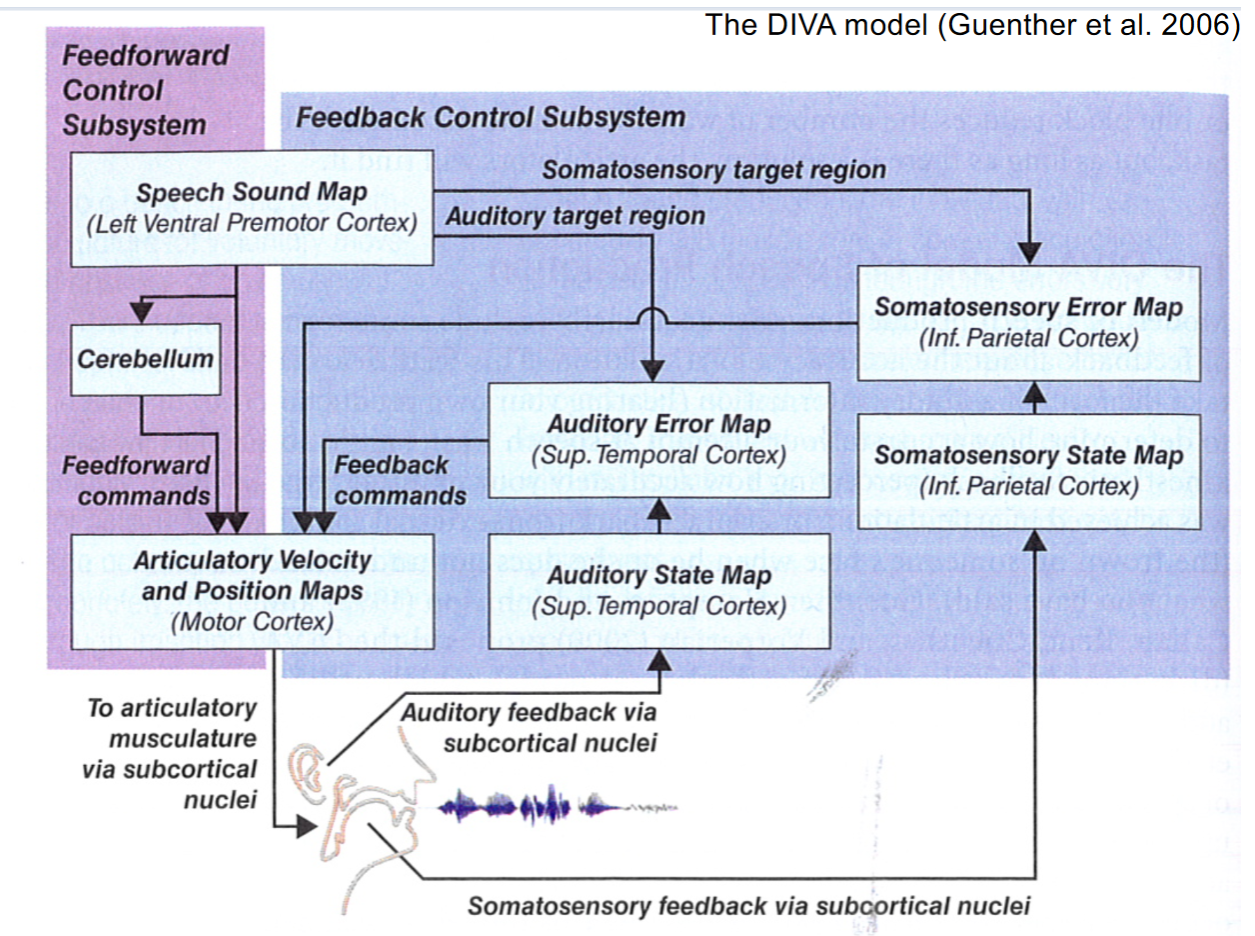Note
0.0(0)
Explore Top Notes Note
Note Studied by 59 people
Studied by 59 people Note
Note Studied by 1 person
Studied by 1 person Note
Note Studied by 87 people
Studied by 87 people Note
Note Studied by 75 people
Studied by 75 people Note
Note Studied by 14 people
Studied by 14 people Note
Note Studied by 8 people
Studied by 8 people
Sensation and Perception
4.0(1)
ELEKTŘINA
5.0(1)
Chapter 7: Cell Communication and Cell Cycle
5.0(2)
AP Biology Unit 1 Notes
5.0(1)
The Living World
5.0(1)
Untitled
5.0(1)
Lecture 21 – DIVA model.docx
Lecture 21 – DIVA model
04.04.24

- DIVA model explained
- The speech sound map of the premotor cortex controls the articulator velocity and position maps (lower left) which, in turn, control the muscles of speech
- The output of the cortex is fed to somatosensory and auditory error-map regions responsible for monitoring the accuracy of production based on the proposed plan produced at the premotor cortex
- The error monitoring system serves as feedback control, which modifies the output over time during learning
- Eventually the feedforward control has been modified sufficiently that feedback is no longer critically essential until a perturbation occurs in the system
- That requires error correction (🡪 feedback loop)
- Such a perturbation could be
- Anesthesia from dental work
- Or inserting a tube into the mouth
- To a swollen lip or tongue
- To motor disturbance arising from neuromuscular disease
- Or simply an experiment where the auditory feedback is altered (phonetic experiments)
- For normal speech the feedback loop is turned off (otherwise speech production would be too slow) 🡪 only activated when necessary (i.e. perturbation occurs)
- General requirement for a speech model:
- Feedback:
- Auditory information (hearing your own voice and determine how exact targets have been reached)
- Tactile and kinestheic feedback (how accurately your production was achieved in articulation (e.g. collision control or precision of closure/narrow channel for plosive vs fricative)
- External sources (e.g. frown on someone’s face if they did not understand)
- Feedback:
- DIVA model contains mirror neurons model to match production to perception (a “model” of the desired speech sound is sent from the premotor cortex to the perceptual regions) 🡪 if mirror neuron “model” does not correspond to achieved acoustic output of the muscle model then muscle model is modified in the next trials 🡪 but this concept is still highly disputed
- DIVA model summary
- The DIVA model established that learning takes place due to the feedback system of error correction
- Learned accuracy carries us through task of talking (feedforward)
- Failure to turn off the feedback leads to typical pathological speech pattern (e.g. stuttering)
- Model can be used to drive speech synthesizers and thus help patients with pathological conditions (e.g. locked-in syndrome, speech motor disorders)
- DIVA model in applied sciences: stuttering
- It takes 75 to 150 ms for auditory information to reach the cerebral cortex 🡪 that is too long to produce fluent running speech (e.g. an unstressed syllable is often only 100ms long)
- So we have to disable the feedback loop for faster speech
- 🡪 that is the reason why we speak slower when learning new languages (learning process)
- 🡪dysfluency very similar to stuttering can be achieved when we do not disable the feedback part of the model and increase the speech rate -> in other words, in stuttering the feedback part of the model cannot be turned off, causing interference between the continuous auditory feedback and the motor planning for the following phonemes
- DIVA model in applied sciences: Locked-in syndrome
- Sensors have been implanted in the model-appropriate reginos of a young patients with locked-in syndrome (following a stroke after a traumatic brain injury)
- The researchers first identified the area of the atient’s brain that was active when the patient imagined himself speaking 🡪 these regions are likely to be involved in the active production of speech
- They then implemented a “neural prosthesis” that could read activity in these regions
- These activations run a speech synthesizer based on the specific phonemes that the patient is thinking of producing
- This DIVA-human combination can now successfully and consistently produce three vowels
Note
0.0(0)
Explore Top Notes Note
Note Studied by 59 people
Studied by 59 people Note
Note Studied by 1 person
Studied by 1 person Note
Note Studied by 87 people
Studied by 87 people Note
Note Studied by 75 people
Studied by 75 people Note
Note Studied by 14 people
Studied by 14 people Note
Note Studied by 8 people
Studied by 8 people
Sensation and Perception
4.0(1)
ELEKTŘINA
5.0(1)
Chapter 7: Cell Communication and Cell Cycle
5.0(2)
AP Biology Unit 1 Notes
5.0(1)
The Living World
5.0(1)
Untitled
5.0(1)